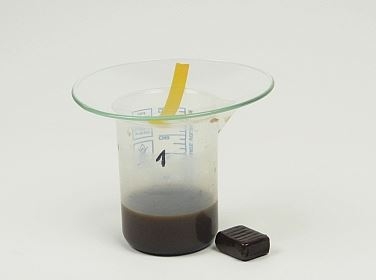Ammonia in liquorice Principle
Liquorice has a sharp taste, because it contains ammonium chloride. Ammonia can be detected with sodium hydroxide solution, chloride with silver nitrate. It can be shown by the example ammonia and ammonium salts, that substances can be used for very different purposes, according to their concentration. Learning objectives Benefits - Easy teaching and efficient learning by using interactive experimentation PHYWE-Software
- Experiment is part of a complete solution set with experiments for the topic Food Chemistry matched with international curriculum: all topics are covered
Scope of delivery |
Spoon, special steel
|
33398-00
|
1
| |
Wash bottle, 250 ml, plastic
|
33930-00
|
1
| |
Watch glass, dia.100 mm
|
34574-00
|
2
| |
Beaker, 100 ml, plastic (PP)
|
36081-00
|
2
| |
Graduated cylinders, plastic, various sizes
|
36629-01
|
1
| |
Test tube, laboratory glass, various lengths, 100 pcs.
|
37658-10
|
1
| |
Test tube brush w. wool tip,d20mm
|
38762-00
|
1
| |
Test tube rack, wood, for 6 tubes d= 22mm
|
MAU-20042200
|
1
| |
Laboratory pen, waterproof, black
|
38711-00
|
1
| |
Test tube holder, up to d 22mm
|
38823-00
|
1
| |
Protecting glasses, clear glass
|
39316-00
|
1
| |
Rubber gloves, size M (8), one pair
|
39323-00
|
1
| |
Glass rod, boro 3.3, l=200mm, d=6mm
|
40485-04
|
2
| |
Pipette with rubber bulb
|
64701-00
|
3
| |
Ammonium chloride 250 g
|
30024-25
|
1
| |
Nitric acid 1,40 g/ml, 65%, 500 ml
|
30213-50
|
1
| |
Silver nitrate solution 5% 100 ml
|
30223-10
|
1
| |
Caustic soda sol. 32% 1000 ml
|
30266-70
|
1
| |
Water, distilled 5 l
|
31246-81
|
1
| |
Indicator paper, pH1-14, roll
|
47004-02
|
1
|
|



